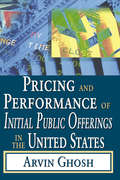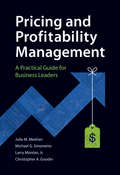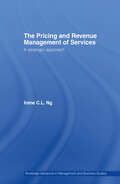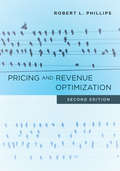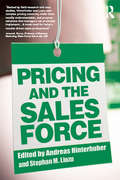- Table View
- List View
Priceline.com: Name Your Own Price
by Robert J. DolanPriceline.com is a new concept shifting the setting of price from sellers to buyers. The company aspires to use its patented process of advertising units of demand at named prices to suppliers in many categories. This case focuses on its initial use in the airline industry.
The Priceline Group: Booking a Place for the Future
by Leonard A. Schlesinger Anish PathipatiThe Chairaman of the Priceline Group is considering the actions he must take to confront an evolving external environment, new direct competition, disintermediation and substitute offerings. Does his response require an increased coordination of each historically autonomous division r some other approach?
The Priceline Group: Booking a Place for the Future
by Anish Pathipati Leonard A. SchlesingerThe Chairman of the Priceline Group is considering the actions he must take to confront an evolving external environment, new direct competition, disintermediation and substitute offerings. Does his response require an increased coordination of each historically autonomous division or some other approach?
Prices and Knowledge: A Market-Process Perspective (Routledge Foundations of the Market Economy)
by Esteban F. ThomsenFirst published in 1992. Routledge is an imprint of Taylor & Francis, an informa company.
Prices and Quantities: Fundamentals of Microeconomics
by Rakesh V. VohraRakesh V. Vohra offers a unique approach to studying and understanding intermediate microeconomics by reversing the conventional order of treatment, starting with topics that are mathematically simpler and progressing to the more complex. The book begins with monopoly, which requires single variable rather than multivariable calculus and allows students to focus clearly on the fundamental trade-off at the heart of economics: margin versus volume. Imperfect competition and the contrast with monopoly follows, introducing the notion of Nash equilibrium. Perfect competition is addressed toward the end of the book, and framed as a model of non-strategic behavior by firms and agents. The last chapter is devoted to externalities, with an emphasis on how one might design competitive markets to price externalities and linking the difficulties to the problem of efficient provision of public goods. Real-life examples engage the reader while encouraging them to think critically about the interplay between model and reality.
Prices and Wages in England
by William BeveridgePrices and wages are the social phenomena most susceptible of objective statistical record over long periods of time. They reflect and measure the influence of changes in population, in supply of precious metals, in industrial structure and agricultural methods, in trade and transport, in consumption and in the technical arts. Forming part of publications of the International Committee on Price History, this is Volume I of data from the twelfth to the nineteenth century. It was originally published in 1939 and almost the entire stock was destroyed during an air-raid. The present volume is a facsimile of that edition. This volume looks at the Mercantile era.
Prices and Welfare: An Introduction to the Measurement of Well-being when Prices Change
by Abdelkrim Araar Paolo VermeThis book provides a general framework for the use of theoretical contributions in empirical works, addressing the question of what is the effect of a price change on household well-being. This simple question is one of the most relevant and controversial questions in microeconomic theory and one of the main sources of errors in empirical economics. In particular, this book aims to 1) Review the essential microeconomics literature since the first seminal papers by Hicks in the 1930s; 2) Organize and simplify this literature in a way that can be easily used by analysts with different backgrounds providing algebraic, geometric and computational illustrations; 3) identify and measure the essential differences across methods and test how these differences affect empirical results; 4) Provide guidelines for the use of alternative approaches under imperfect information on utility, demand systems, elasticities and more generally incomes and quantities; 5) Provide computational codes in Stata for the application of all methods. The focus of the book is on developing economies and the poor, and the assumptions made will relate primarily to these countries and group of people, presumably the main policy focus of international organizations and national governments.
Pricing: Design and Implementation
by Samuel ChunProvides general managers with a framework with which they can structure and understand pricing decisions. Draws examples from existing HBS case materials.
Pricing: A Value-Based Approach
by Robert J. DolanPresents a framework for determining prices for products and services in concert with the value provided to customers. Discusses methodologies for estimating customer value.
Pricing Analytics: Models and Advanced Quantitative Techniques for Product Pricing
by Walter R. PaczkowskiThe theme of this book is simple. The price – the number someone puts on a product to help consumers decide to buy that product – comes from data. Specifically, itcomes from statistically modeling the data. This book gives the reader the statistical modeling tools needed to get the number to put on a product. But statistical modeling is not done in a vacuum. Economic and statistical principles and theory conjointly provide the background and framework for the models. Therefore, this book emphasizes two interlocking components of modeling: economic theory and statistical principles. The economic theory component is sufficient to provide understanding of the basic principles for pricing, especially about elasticities, which measure the effects of pricing on key business metrics. Elasticity estimation is the goal of statistical modeling, so attention is paid to the concept and implications of elasticities. The statistical modeling component is advanced and detailed covering choice (conjoint, discrete choice, MaxDiff) and sales data modeling. Experimental design principles, model estimation approaches, and analysis methods are discussed and developed for choice models. Regression fundamentals have been developed for sales model specification and estimation and expanded for latent class analysis.
Pricing and Cost Accounting: A Handbook for Government Contractors
by Darrell J. Oyer CPAThe essential reference to help federal contractors negotiate and maintain profitable contracts—Now in its third edition!This is the essential reference to help federal contractors negotiate and maintain profitable contracts—and remain in compliance throughout the life of the contract.Government contracting rules and regulations have changed significantly over the past six years. This new third edition addresses these changes and more:New thresholds for certification of cost and pricing dataRevisions in cost accounting standardsImplementation of commercial time-and-material and labor-hour contractsNew, stringent ethics requirementsImpact of stimulus fundingRevised cost principles, including excessive pass-through costs, post-retirement benefits, and travel costsRedirected audit initiatives based on the GAO review of DCAAPlus…changed requirements for bidding…pricing…cost accounting…subcontracting…contract modification…all the information you need to be in compliance with the new rules. No other single book provides as much up-to-date federal procurement cost and pricing information in such a concise - yet comprehensive - format.
Pricing and Equilibrium (Routledge Library Editions)
by Erich SchneiderThis volume analyses value and equilibrium. Chapters on the decisions of household and on the theory of the firm (including short and long-term planning and investment) include both static and dynamic analysis.* Based on the enlarged sixth German edition this English edition contains many diagrams and an introduction to linear programming, as well as full treatment of the author's well-known theory of production.
Pricing and Hedging Financial Derivatives
by Leonardo Marroni Irene PerdomoThe only guide focusing entirely on practical approaches to pricing and hedging derivatives One valuable lesson of the financial crisis was that derivatives and risk practitioners don't really understand the products they're dealing with. Written by a practitioner for practitioners, this book delivers the kind of knowledge and skills traders and finance professionals need to fully understand derivatives and price and hedge them effectively. Most derivatives books are written by academics and are long on theory and short on the day-to-day realities of derivatives trading. Of the few practical guides available, very few of those cover pricing and hedging-two critical topics for traders. What matters to practitioners is what happens on the trading floor-information only seasoned practitioners such as authors Marroni and Perdomo can impart. Lays out proven derivatives pricing and hedging strategies and techniques for equities, FX, fixed income and commodities, as well as multi-assets and cross-assets Provides expert guidance on the development of structured products, supplemented with a range of practical examples Packed with real-life examples covering everything from option payout with delta hedging, to Monte Carlo procedures to common structured products payoffs The Companion Website features all of the examples from the book in Excel complete with source code
Pricing and Human Capital: A Guide to Developing a Pricing Career, Managing Pricing Teams, and Developing Pricing Skills
by Stephan M LiozuThe pricing profession has come a long way: from having a pure clerical function back in the 1970s to a more strategic one today, pricing professionals are increasingly accepted as fully fledged members of marketing and finance teams. However, in many of these organizations, pricing professionals are often misunderstood and neglected from a career and talent perspective. Furthermore, the literature is still silent on how to manage and develop pricing teams. Pricing and Human Capital explores the specific nature of pricing human resources and focuses on how to manage pricing teams, pricing talent, pricing careers and how to organize the pricing function for success. It is dedicated to the pricing function and is aimed at helping pricing professionals manage their career within marketing, finance, sales or IT departments. By focusing on specific practical tips, tools and recommendations that pricing and HR teams can adopt to improve their relationships, and including extensive interviews with senior pricing executives, it is the perfect toolkit for both HR and pricing professionals. This valuable textbook with its collection of cases in pricing will also be essential for students and tutors of marketing and sales.
Pricing and Liquidity of Complex and Structured Derivatives
by Mathias SchmidtThis book introduces the "strike of default" (SOD) benchmark concept. The author determines the SOD through cross-sectional pricing between the credit market and the option market, considering the same underlying. The idea of the SOD is to combine the implied probability of default from both markets to get a time-depending share price, at which the markets believe the underlying will default. By means of credit default swaps (CDS) and option pricing methods, the SOD is determined for any exchange-listed company, where option and CDS market data are available.
Pricing and Liquidity of Complex and Structured Derivatives: Deviation of a Risk Benchmark Based on Credit and Option Market Data (SpringerBriefs in Finance)
by Mathias SchmidtThis book introduces the “strike of default” (SOD) benchmark concept. The author determines the SOD through cross-sectional pricing between the credit market and the option market, considering the same underlying. The idea of the SOD is to combine the implied probability of default from both markets to get a time-depending share price, at which the markets believe the underlying will default. By means of credit default swaps (CDS) and option pricing methods, the SOD is determined for any exchange-listed company, where option and CDS market data are available.
Pricing and Market Making on the Internet
by Robert J. Dolan Youngme MoonConsiders the impact of the Internet on how market exchanges will take place. Discusses the role of shopping agents and alternatives to fixed prices such as negotiations, auctions, and exchanges.
Pricing and Partnership at Zillow, Inc.
by Peter A. Coles Benjamin EdelmanAs Zillow's real estate search service gains user adoption, some real estate professionals question Zillow's policies, fees, and power. Dissatisfied real estate professionals could remove listings from Zillow, reducing the service's value to users. Should Zillow adjust its approach in order to address complaints?
Pricing and Performance of Initial Public Offerings in the United States
by Arvin GhoshIn this timely volume on newly emerging financial mar- kets and investment strategies, Arvin Ghosh explores the intriguing topic of initial public offerings (IPOs) of securities, among the most significant phenomena in the United States stock markets in recent years. Before the 2000-2001 market turndown, hardly a week went by when more than a few companies did not become public, either in the organized stock exchange or in the Over the Counter (OTC) market. In the often over-burdened, technology-heavy Nasdaq market, the role of IPOs was crucial for the market's new vigor and growth. Internet stocks were able to find a mode to supply key momentum to the market. In the so-called "New Economy" of the 1990s, it was the seductively accessible IPO that ushered in the world's information technology revolution.Ghosh sets out to examine the pricing and financial performance of IPOs in the United States during the period 1990-2001. In the opening chapter he discusses the rise and fall of IPOs in the preceding decade. Chapter 2 further delineates the IPO process from the start of the prospectus to the end of the "quiet period" and aftermarket stabilization. In chapter 3 Ghosh analyzes the mispricing and deliberately deceptive underpricing, or "flipping," of Internet IPOs. Chapter 4 delves deeper into the pricing and operating efficiency of Nasdaq IPOs. Chapter 5 analyzes the pricing and long-run performance of IPOs both in the New York Stock Exchange and in the Nasdaq markets. In chapters 6 and 7 the author deals with the pricing and performance of the venture-blocked and nonventure-backed IPOs in general and Internet IPOs in particular. In chapter 8 he analyzes the role of underwriters as market makers. In chapter 9 Ghosh discusses the accuracy of analysts' earnings forecasts. In the concluding chapter, he summarizes the principal findings of the study and the recent revival of the IPO market and its place in capital formation as well as the latest developments in t
Pricing and Profitability Management
by Julie M. Meehan Michael G. Simonetto Christopher A. Goodin Larry Montan Jr.The practical guide to using pricing and profitability management to build a better business A comprehensive reference for any business professional looking to understand the capabilities and competencies required for effectively managing pricing and profitability, Pricing and Profitability Management explains how to determine the right approach, tools, and techniques for each of six key categories (pricing strategy, price execution, advanced analytics and optimization, organizational alignment and governance, pricing technology and data management, and tax and regulatory effectiveness). Exploring each category in detail, the book addresses how an integrated approach to pricing improvement can give a sustainable, competitive advantage to any organization. The ultimate "how to" manual for any executive or manager interested in price management, the book presents a holistic, comprehensive framework that shows how integrating these pricing categories into a cohesive program leads to impressive gains that cannot be achieved through a single-pronged approach. Presents a comprehensive framework for more effectively managing pricing and profitability Identities the six key categories of pricing and profitability management Shows you how to gain a competitive edge by managing pricing and profitability Taking a comprehensive view of pricing, companies can position themselves to tap a vast source of shareholder value--the ability to set and enforce profitable prices, not just once, but again and again in response to marketplace changes and evolving business needs--and this book will show you how.
The Pricing and Revenue Management of Services: A Strategic Approach (Routledge Advances In Management And Business Studies #Vol. 36)
by Irene C.L. NgIn a world of changing lifestyles brought about by new services, technology and e-commerce, this book enters the arena of contemporary research with particular topicality. Integrating both theory and real world practices, Ng advances the latest concepts in pricing and revenue management for services in a language that is useful, prescriptive and ye
Pricing and Revenue Optimization
by Robert L. PhillipsThis is the first comprehensive introduction to the concepts, theories, and applications of pricing and revenue optimization. From the initial success of “yield management” in the commercial airline industry down to more recent successes of markdown management and dynamic pricing, the application of mathematical analysis to optimize pricing has become increasingly important across many different industries. But, since pricing and revenue optimization has involved the use of sophisticated mathematical techniques, the topic has remained largely inaccessible to students and the typical manager. With methods proven in the MBA courses taught by the author at Columbia and Stanford Business Schools, this book presents the basic concepts of pricing and revenue optimization in a form accessible to MBA students, MS students, and advanced undergraduates. In addition, managers will find the practical approach to the issue of pricing and revene optimization invaluable.
Pricing and Revenue Optimization: Second Edition
by Robert L. PhillipsThis book offers the first introduction to the concepts, theories, and applications of pricing and revenue optimization. From the initial success of "yield management" in the commercial airline industry down to more recent successes of markdown management and dynamic pricing, the application of mathematical analysis to optimize pricing has become increasingly important across many different industries. But, since pricing and revenue optimization has involved the use of sophisticated mathematical techniques, the topic has remained largely inaccessible to students and the typical manager. With methods proven in the MBA courses taught by the author at Columbia and Stanford Business Schools, this book presents the basic concepts of pricing and revenue optimization in a form accessible to MBA students, MS students, and advanced undergraduates. In addition, managers will find the practical approach to the issue of pricing and revenue optimization invaluable. With updates to every chapter, this second edition covers topics such as estimation of price-response functions and machine-learning-based price optimization. New discussions of applications of dynamic pricing and revenue management by companies such as Amazon, Uber, and Disney, and in industries such as sports, theater, and electric power, are also included. In addition, the book provides current coverage of important applications such as revenue management, markdown management, customized pricing, and the behavioral economics of pricing.
Pricing and Risk Management of Synthetic CDOs
by Anna SchlösserThis book considers the one-factor copula model for credit portfolios that are used for pricing synthetic CDO structures as well as for risk management and measurement applications involving the generation of scenarios for the complete universe of risk factors and the inclusion of CDO structures in a portfolio context. For this objective, it is especially important to have a computationally fast model that can also be used in a scenario simulation framework. The well known Gaussian copula model is extended in various ways in order to improve its drawbacks of correlation smile and time inconsistency. Also the application of the large homogeneous cell assumption, that allows to differentiate between rating classes, makes the model convenient and powerful for practical applications. The Crash-NIG extension introduces an important regime-switching feature allowing the possibility of a market crash that is characterized by a high-correlation regime.
Pricing and the Sales Force
by Andreas Hinterhuber Stephan M LiozuPricing and the Sales Force is the first book to link pricing strategy and the sales force together. Pricing strategy is now well established as an important means of driving profits for many organizations. Countless companies are now mastering price-setting. But what about "price-getting" – converting those list prices into the realized sales, and as a result, greater profitability? This is the domain of the sales force. A selection of the world’s leading specialists explore different aspects of sales force and pricing strategy integration: introduction: overview on the state of the art; building key capabilities: best practices for building sales force capabilities in pricing and value quantification; engaging the sales force: driving organizational change processes with the sales force; designing effective selling processes: designing and implementing processes that enable superior performance, and; aligning sales force incentives and building the infrastructure: insights into how to align sales force incentive schemes; tools and instruments to enable the sales force to perform. The third in Hinterhuber and Liozu’s successful pricing series, this book is essential reading for pricing strategy and sales scholars and practitioners.











